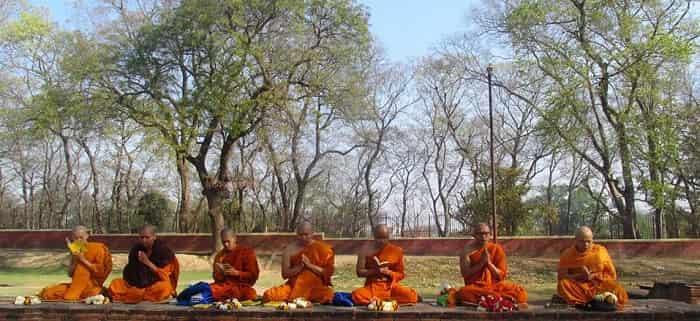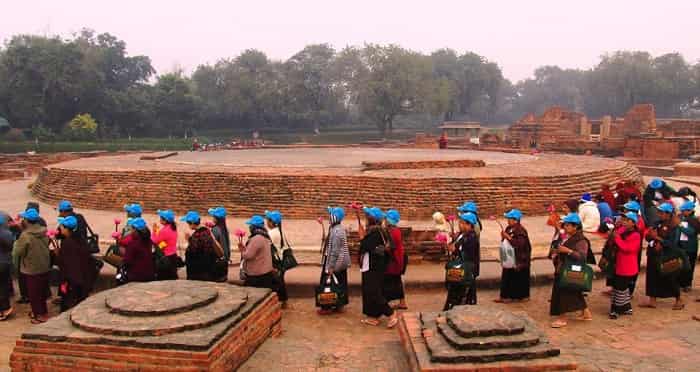Last Updated on 16/12/2023
Welcome to this site of sacred deer park where Gautama Buddha taught Dharma for the first time following his enlightenment. Situated at 12 km from the Hindu pious city of Varanasi, Sarnath is considered among the four blessed Buddhist sites endorsed by Lord Buddha including Lumbini – his Birthplace, Bodh Gaya – his Enlightenment site, and Kushinagar – his death site.
Legend

Formerly known as Mrigadayavan meaning deer park and Isipatana meaning the site of falling of the holy men onto the planet (In Pali, ‘is’ means holy men). A legend is associated with the second name according to which when Lord Buddha was born, heavenly gods (devas) appeared on Earth to inform about it to 500 holy men who disappeared leading to the fall of their remains on the ground.
The modern name Sarnath (Saranganath) literally indicates Lord of the Deer named after an ancient Buddhist story. According to this, Bodhisattva is a deer who provides his life to a king rather than the doe he wanted to slay. Upon this devotion, the king created the park as a deer’s haven.
Sarnath History

Lord Buddha, when attained enlightenment, first came here to preach his manifested experience, and discovered his first five escorts to make them enlighten. This is called “Spinning the wheel of the Dharma” that commemorates the origin of the Sangha – the congregation of monks. His first sermon was in Pali and is known as the Dhammacakkappavattana Sutta followed by his core teachings on the Four Noble Truths (meaning of life) and the Noble Eightfold Path (the precise manner of living). Residing at Mulagandhakuti Vihara in next rainy season, Lord Buddha’s Sangha totaled to 60 after which he told those monks to reach far and wide and preach the Dharma to the people.
After Buddha, Buddhism grew in leaps and bounds in Sarnath due to the backing of kings and rich trade People of Varanasi. Until the 3rd century, Sarnath famed its name as an important hub of arts towering the sky at the time of the Gupta period that was from 4th to 6th century. According to Hsuan Tsang who visited Sarnath in the 7th century from China, there were 30 monasteries and 3000 monks. Later, Sarnath was a prime hub of the Sammatiya school of Buddhism, which is among the Nikaya or Hinayana schools.
However, at the end of the 12th century, Turkish Muslims attacked the town damaging almost all the prime buildings and monuments after which it was looted for making other structures. This ruined state is what you see today. Finally, until 1836 A.D., the location was completely made empty and it was at this time when the British started their digit activity along with renovation.
Sarnath Attractions
This is an imposing structure of 128 feet high with 46.5 as radius among the ruins. This marks the holy place where Lord Buddha is supposed to have Teacher his first companion. The Stupa was built somewhere around 200 BC. You can see only its foundations, but worth noting, as it is a rare pre-Ashokan stupa.
Mulagandhakuti Vihara
Now as crumbling ruins, this is the site where Lord Buddha stayed in meditation at the time of his first rainy season after enlightenment. According to a writer of the 7th century, the Vihara was 200 feet high and had 100 niches housing a carving of the Buddha along each wall. Here, a life-sized idol depicts Buddha spinning the wheel of Dharma.
Modern Mulagandhakuti Vihara
Located to the east of the ruined one, this modern Vihara boasts wonderful wall paintings. At its rear, there is the Deer Park that is actually a free animal park alluring deer.
The Ashoka Pillar
The pillar’s base is still surviving at its initial location and offers some pleasant carvings. Although it was alive after the Turkish invasion, later, it was wrecked at the time of excavations.
Sarnath Archaeological Museum
This displays the glorious lion capital once sitting on the pillar and yet survived after its fall from 45 foot. In addition, you can have a glimpse of some of the hidden gems of the Indian Buddhist art with its 300 images.
Bodhi Tree
Situated besides a Sri Lankan Monastery, this tree considered as sacred was planted by Anagarika Dharmapala that was cut from the Bodhi tree at Bodh Gaya. It is said that below this tree at Bodh Gaya, Gautam Buddha achieved enlightenment.
Six National Temples
These were built by different Asian communities at Sarnath after the restoration of the site. A Tibetan temple and Sri Lankan temple are a part of these shrines.
Suggested Tour



 Call
Call WhatsApp
WhatsApp Enquiry
Enquiry